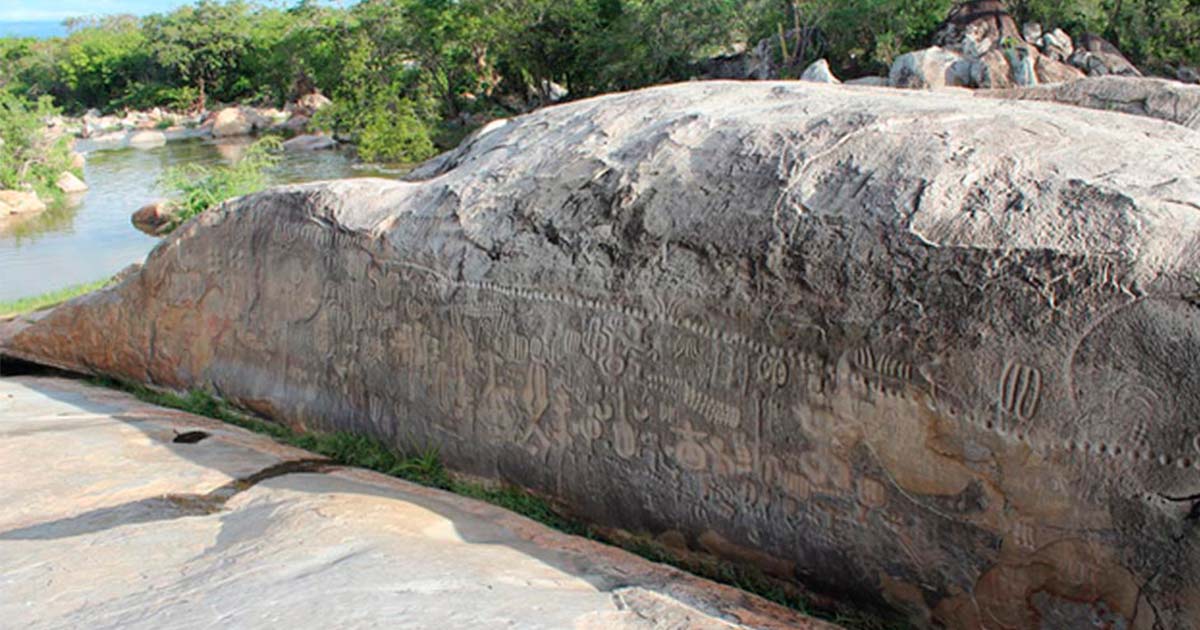Deep within the Brazilian state of Paraíba lies a fascinating archaeological enigma that has captured the imagination of researchers and visitors alike for centuries—the Ingá Stone.

The Ingá Stone, also known as “Pedra do Ingá” in Portuguese, is a colossal rock formation located in the middle of the Ingá River near the small city of Ingá, in northeastern Brazil. It measures approximately 3.8 meters (12.5 ft) in height and 46 meters (151 ft) in length, making it one of the largest inscribed stones in the world. Its surface is adorned with intricate engravings depicting a vast array of symbols, including humans, animals, geometric shapes, and cryptic hieroglyphs.
The origins of the Ingá Stone remain shrouded in mystery, with its exact age and purpose still subject to debate among scholars. Most geologists, however, estimate that the rock formation dates back at least 6,000 years. And the carvings on it were most probably created by natives who lived in the area until the 18th century.

Several theories have emerged in an attempt to explain the purpose and meaning behind the Ingá Stone’s engravings. One hypothesis suggests that the symbols represent an ancient written language or system of communication, yet to be deciphered. Others propose that the stone may have functioned as a religious or spiritual site, serving as a medium for ancient rituals or ceremonies. Some even speculate that the engravings are a map or guide, providing directions to hidden treasures or sacred locations. And some go so far as to suggest that a spaceship had landed in the Inga area and the symbols were drawn on the rock by the extraterrestrial guests themselves.

Let’s stay with the more scientifically sound theories though. One prominent hypothesis that has been put forth assigns remarkable significance to the petroglyphs of the Ingá Stone from an archeoastronomical perspective. In 1976, Francisco Pavía Alemany, a Spanish engineer, initiated a mathematical study of this archaeological monument and identified a series of “bowls” and another petroglyph engraved on the vertical surface, which formed a “solar calendar.” According to Alemany, a gnomon cast the shadow of the first rays of sunlight each day onto this calendar.
Subsequently, F. Pavia pursued further research, shifting his focus to a set of engravings on the rocky surface, which he interpreted as a multitude of “stars” arranged in “constellations.” The presence of both the “bowls” and the “constellations” on the same rock is believed to bestow significant archeoastronomical value upon it.
In the early twentieth century, Ludwig Schwennhagen, originally from Austria, conducted extensive research on Brazilian history. His studies revealed striking resemblances between the symbols present on the Ingá Stone and the iconography associated not only with the Phoenicians but also with the demotic writings, primarily used for business and literary documents, of ancient Egypt. Additionally, other groups of researchers discovered a remarkable similarity between the carvings found on the Ingá Stone and the indigenous artwork found on Easter Island.
A recent study by Telma Costa takes the language theory one step further by arguing that besides the verification of the origin of languages that evidently derived from the botanical knowledge, the Ingá stone reveals an ancient people’s knowledge of the fertilization and crossing of the Ingazeira (a type of Brazilian tree).
“The flower of the angiosperm species that, as biologists usually present in their cyclic schemes, is found in the middle of the ground so that we can see its interior and the way in which a double fertilization of the species occurs, is described in the stone of the Ingá. This means that the stone of the Ingá brings in its curious figures nothing more than symbols representative of the lunar cycles referring to the time and the double fertilization of the angiosperm, referring to the flower of the Ingazeira,” he writes.
Well, an interesting theory indeed. And although the Ingá Stone will certainly continue to be a captivating enigma, challenging our understanding of Brazil’s ancient history and indigenous cultures, there’s one thing that Costa’s research definitely shows. Namely, that the solution to the secrets of the past are often to be found in the simpler things – such as the things found in the natural environment that surrounded those cultures.
Like a certain type of tree, for example.
Sources: 1, 2, 3, 4
Written by Tamás Varga
A sociologist and English major by degree, I’ve worked in the area of civil society & human rights and have been blogging in the fields of travel, nature & science for over 20 years.